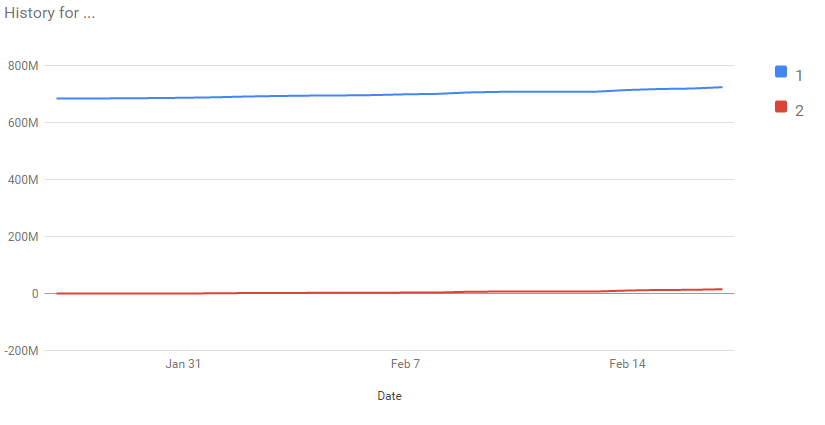I am not able to create a logarithmic vertical axis for my material Google Line Chart. Documentation states that I should set vAxis.logScale to true in the options, but this leads to no result.
Currently my test reads:
<div class="chart"></div>
<script src="https://ajax.googleapis.com/ajax/libs/jquery/2.1.4/jquery.min.js"></script>
<script src="https://www.gstatic.com/charts/loader.js"></script>
<script>
google.charts.load("current", { "packages": [ "line", "corechart" ]});
google.charts.setOnLoadCallback(function() {
var data = new google.visualization.DataTable();
data.addColumn("date", "Date");
data.addColumn("number", "1");
data.addColumn("number", "2");
data.addRows([
[ new Date(2016, 0, 27), 684130172, -1 ], [ new Date(2016, 0, 28), 684189642, -1 ], [ new Date(2016, 0, 29), 684837381, 122895 ], [ new Date(2016, 0, 30), 685595817, 238244 ], [ new Date(2016, 0, 31), 686690845, 239450 ], [ new Date(2016, 1, 1), 688391639, 536141 ], [ new Date(2016, 1, 2), 691181274, 1651530 ], [ new Date(2016, 1, 3), 693040518, 1698813 ], [ new Date(2016, 1, 4), 694335907, 2271617 ], [ new Date(2016, 1, 5), 694978502, 2314718 ], [ new Date(2016, 1, 6), 696142818, 2314758 ], [ new Date(2016, 1, 7), 698869181, 3234042 ], [ new Date(2016, 1, 8), 700446296, 3338104 ], [ new Date(2016, 1, 9), 705552668, 6175539 ], [ new Date(2016, 1, 10), 707540295, 6812427 ], [ new Date(2016, 1, 11), 707766077, 6831641 ], [ new Date(2016, 1, 12), 707922926, 6839607 ], [ new Date(2016, 1, 13), 708061736, 6883806 ], [ new Date(2016, 1, 14), 713986011, 10366780 ], [ new Date(2016, 1, 15), 717491978, 12527120 ], [ new Date(2016, 1, 16), 719057078, 12794871 ], [ new Date(2016, 1, 17), 723813184, 14959625 ], ]);
var chart = new google.charts.Line($(".chart")[0]);
chart.draw(data, {
chart: {
title: "History for ..."
},
height: 400,
width: 800,
vAxis: {
logScale: true,
minValue: 0
}
});
});
</script>
And produces:
I have used a lot of combinations of options but I haven't yet produced any logarithmic result.


google.charts.Line.convertOptionsfor 'material' options? – Electrolytic